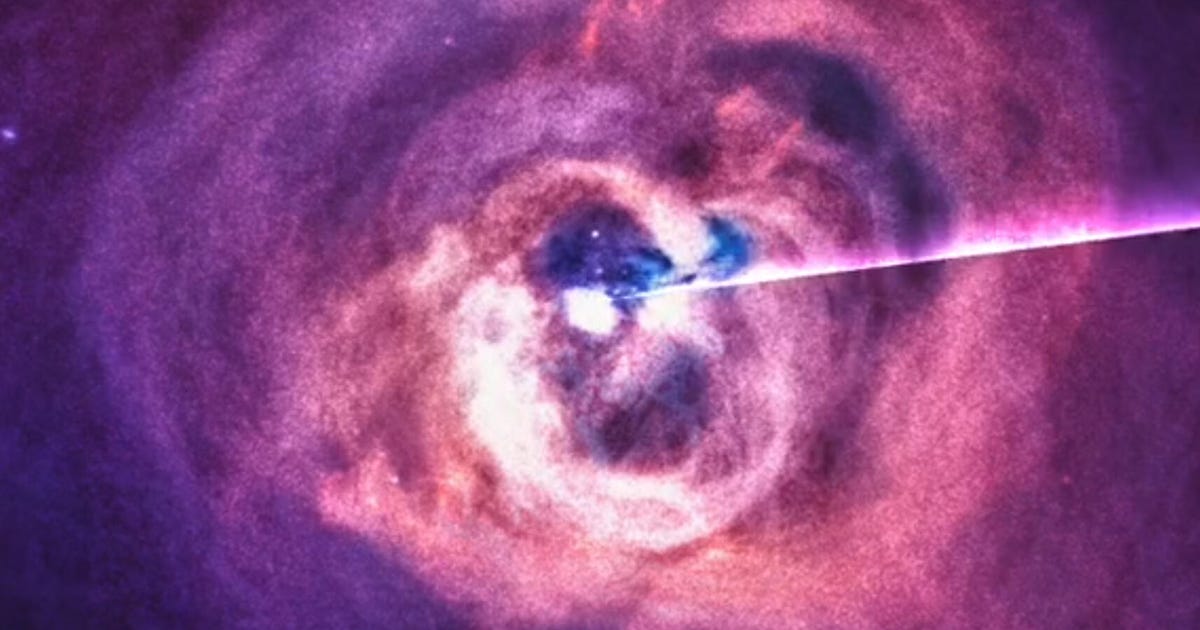
NASA's Haunting Remix Lets You Hear What a Black Hole Sounds Like
During black hole week, back in May, NASA dropped a remix that will haunt you until the end of your days.
More specifically, the space agency made a melody from the soundwaves of a vast, monstrous black hole that sits more than 200 million light-years away from Earth. The black hole is found in the center of what's known as the Perseus galaxy cluster, which is a majestic 11 million-light-year-wide bundle of galaxies shrouded by hot gas.
And although the sheer magnitude of Perseus and its galaxies is jaw-dropping, astronomers have been most interested in … all that hot gas. The space clouds are precisely why we're able to hear the sounds of something we can barely even see or conceptualize: the massive black hole at Perseus' center.
They're likely exactly what you'd expect a black hole to sound like: eerie, scary, mysterious, maybe something Thom Yorke can sample for his next album. Maybe even pained, if you listen carefully enough.
Anyway, now that you have your black hole week soundtrack, here are the specifics of what you're hearing.
Decades ago, astronomers discovered Perseus' void-like interior sends out pressure waves. These waves sort of ripple through all the surrounding hot gas in the area, and those ripples, in essence, can be translated into sound.
Think of sound waves as the vibration of air -- or rather, the vibration of things (atoms, molecules) within the air. Our ears can capture those vibrations and turn them into listenable noise here on Earth, but in space, things are a little different.
Because space is a vacuum, there isn't any medium for sound waves to travel through. This is why space is often considered totally quiet. But the silence isn't because cosmic objects aren't making sounds. Their waves just don't have anything to vibrate.
Perseus' black hole, on the other hand, gets past this space vacuum sound barrier because it's so close to the cluster's gas. It can create sound wave vibrations, and those are the hot gas ripples scientists are focused on.
As such, in 2003, a team from NASA's Chandra X-ray Observatory took astronomical data from the gassy ripples and translated that into normal sound waves we're used to on Earth. But, for a long time, there was a major hurdle preventing us from listening to the black hole's song. When scientists completed the translation, or sonification process, they found that Perseus' abyss plays a note that's a whopping 57 octaves below middle C.
Our human ears can't hear that, which is where NASA's remix comes in.
In honor of black hole week, the agency extracted the already-identified black hole sound waves and scaled them up by 57 and 58 octaves so we can all, finally, listen to the call of the void.
"Another way to put this," NASA said, "is that the [sound waves] are being heard 144 quadrillion and 288 quadrillion times higher than their original frequency."
And, as an added bonus, NASA also released another, much less ominous, black hole sonification. This one's of the abyss at the center of the galaxy Messier 87, aka the black hole that's famous for being the first-ever photographed chasm.
This track, however, is only so beautiful because it's not exactly the product of pure, isolated astronomical data sonification like the music of Perseus' void. It comes from three different vessels of data -- Chandra X-rays, optical light from Hubble and radio waves from the Atacama Large Millimeter Array in Chile -- overlaid upon one another.
The X-rays play high tones, optical light data play medium tones and radio waves are the alto's with the lowest tones.
Together, they make a bittersweet symphony.
Source
Tags:
- Nasa S Haunting Remix Lets You Hear What A Cochlear
- Nasa S Haunting Remix Lets You Hear What You Want To Hear
- Nasa S Haunting Remix Lets You Hear What You Read
- Nasa S Haunting Remix Lets You Access
- Nasa S Haunting Remix Le ts You Just Drop
- Nasa S Haunting Remix Ide
- Nasa S Haunting Remix To Ignition
- Nasa S Haunting Songs
- Nasa Shirt
- Spot The Station Nasa Sightings
- Nasa Space Station Viewing Schedule
